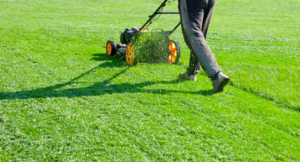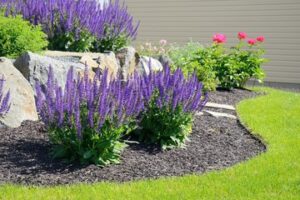A well-maintained lawn provides benefits that extend beyond aesthetics. It improves property value, helps filter water runoff, provides a cool and comfortable outdoor space, and contributes to a healthy community environment.
A healthy lawn is less attractive to pests, fungi, and disease. Good lawn care practices like mowing, aeration, dethatching, and removing plant debris help prevent these problems. Contact Lawn Care Harrisburg PA now!

Lawns have a big impact on our visual perception of a property, and the nuances of their aesthetic can make or break curb appeal. Keeping the grass trimmed, watered, fertilized, free of weeds and bare spots can elevate a yard’s aesthetic. It’s a critical part of creating a welcoming space for guests, allowing them to enjoy the beauty and fresh air of a well-maintained lawn without being distracted by issues like erosion or disease.
A healthy green lawn also demonstrates your commitment to responsible land stewardship. This can have an indirect impact on the surrounding environment, as it reduces stormwater pollution and improves water drainage. By staying up-to-date on the latest trends in lawn care, you can ensure that your landscape is beautiful and sustainable for years to come.
There are a number of different aesthetic options for your lawn, depending on what best suits your personality and home’s design. A clean, minimalist look is a popular trend in landscaping for 2020 and beyond. Broad sweeps of neatly mowed grass are emphasized with simple points of interest, such as a lone shrub or a patch of flowers.
Whether you choose a minimalist style or opt for more colorful hues, a healthy green lawn can increase your property’s value. Not only does it enhance the visual appeal of your home, but it can also create a peaceful retreat where you can relax and unwind.
Research has shown that spending time in natural environments can decrease stress hormone levels. The sight of a lush, green lawn can have an even more significant effect on your mood, helping you feel happier and healthier!
A well-maintained lawn can make a lasting impression on visitors and potential buyers, so it’s important to stay up-to-date on the latest lawn care trends. By choosing a professional lawn service that offers organic fertilizers, weed control and soil health maintenance, you can rest assured that your garden will be beautiful and on-trend this summer. You can also get in touch with your local lawn care company to learn more about xeriscaping, another up-and-coming landscape trend for 2020. Xeriscaping is a great way to conserve water while still having a vibrant yard.
Health
Lawn care has a reputation of being toxic, but when performed conscientiously by well-trained professionals, it actually provides several health benefits. One of the most important is to prevent soil compaction, which can lead to nutrient runoff and environmental harm. Proper lawn mowing techniques, the use of slow-release fertilizers, and frequent aeration reduce soil compaction. This also encourages deep root growth, which promotes healthy turf and helps resist disease.
Another way that lawn care improves health is by removing weeds, which compete for limited resources with trees, plants, and grasses. Weeds often grow more quickly than the grass they surround, which means that the weeds choke out the grass and deprive it of nutrients like nitrogen, potassium, and phosphorus. In addition, many weeds contain plant parts that are toxic to children and pets. By removing weeds from your yard, you can create a safer outdoor environment for your family and pets.
A properly maintained lawn also improves air quality by trapping dust and other soil particles. Additionally, a healthy lawn absorbs carbon dioxide and gives back oxygen through the process of photosynthesis. In contrast, urban air tends to be polluted with particulates and pollutants that blow from cars and factories.
Lastly, a beautiful lawn adds value to your property and makes it easier to enjoy the outdoors. The sound of birds chirping in the trees and the smell of fresh-cut grass can calm the mind, reduce stress, and help people relax and feel connected to nature. Furthermore, the physical activity involved in gardening and lawn care can release endorphins that boost mood and self-esteem.
To reap the health benefits of a lush and vibrant lawn, make sure you hire a professional that offers comprehensive lawn care services, such as organic treatments, weed control, soil health management, tree and shrub health management, and insect pest control. A good lawn treatment company will follow best practices and avoid the use of harmful chemicals that can damage the environment, your pets, and your family.
Safety
A beautiful lawn creates a welcoming atmosphere, elevates property values and contributes to air quality. A well-maintained lawn also prevents erosion, repels insects and diseases, and creates a healthy environment for kids and pets.
Regular mowing, watering and fertilization ensures that the grass is at its healthiest. This promotes thicker turf that is more resilient to pests and diseases.
Professional lawn care companies prioritize safety in all aspects of their work. They have specialized knowledge of different types of grass and their specific nutritional needs. This allows them to customize a fertilization plan that strengthens the lawn and makes it more resistant to weeds and drought. Weed control is another area where lawn service experts excel. They know how to use herbicides correctly to reduce the risk of environmental contamination.
Many harmful insects love to live in unhealthy, overgrown lawns. A regularly-treated lawn discourages most insect infestations, and this can make the yard more livable for families with allergies and other respiratory problems.
Grass absorbs carbon dioxide from the air, releasing fresh oxygen in its place. It can also help to reduce noise pollution by absorbing and dispersing sound waves, preventing the echo effect that can make city living unpleasant.
The roots of a thick turf can help to prevent soil erosion, especially in areas with harsh weather conditions like extreme heat or high winds. A healthy lawn can also act as a natural filter, trapping chemicals from pesticides and fertilizers before they reach groundwater supplies. This helps to protect the health of people and animals that drink from local water sources.
Environment
Lawns offer a natural backdrop for other landscape elements like trees, shrubs and flowers. They reduce noise levels, absorb and deflect sunlight, and help with storm water runoff. They also provide a place for people to relax and connect with nature and each other. A well-kept lawn is a beautiful addition to any property and makes for great curb appeal.
The environment is positively impacted by lawn care that uses organic and non-chemical fertilizers and pest control practices. In contrast, the use of conventional chemical fertilizers and herbicides can result in excessive nutrient runoff into lakes, rivers and streams, leading to eutrophication and toxic algae blooms.
In addition, the use of toxic chemicals in a lawn can lead to human and pet exposure, as well as disrupt the balance of the ecosystem. 59 million pounds of pesticides were used on homes and lawns in 2012, and many of these chemicals leach into the soil and groundwater, posing risks to human health and damaging important ecosystems (Atwood, Jones 2017). In addition, rain runoff from treated lawns can contaminate nearby bodies of water, further exacerbating environmental problems.
Some environmentally friendly lawn maintenance and landscaping methods include the use of mulch to retain soil moisture, aeration to loosen the soil and promote healthy growth, seeding or overseeding to fill in bare areas, and deep root feeding for trees and shrubs. Using compost to amend the soil is another environmentally responsible option.
Grass lawns can be carbon sinks, storing more carbon in the grass plants and soil than they release when the plants decompose. Research by Oregon State University shows that the mowing, fertilizing and irrigation practices most commonly employed contribute to this effect.
Other environmentally friendly practices include choosing drought-resistant grasses that require less water, limiting the amount of time the lawn is watered by setting a schedule and using smart irrigation systems that allow you to monitor soil moisture and adjust your watering accordingly. And leaving grass clippings on the lawn to decompose rather than removing them decreases greenhouse gas emissions by 11 to 59 percent compared to removing them.
